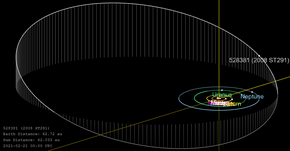 Orbit of (528381) 2008 ST291 Orbit of (528381) 2008 ST291 | |
| Discovery | |
|---|---|
| Discovered by | M. E. Schwamb M. E. Brown D. L. Rabinowitz |
| Discovery site | Palomar Obs. |
| Discovery date | 24 September 2008 |
| Designations | |
| MPC designation | (528381) 2008 ST291 |
| Alternative designations | 2008 ST291 |
| Minor planet category | TNO · SDO res 1:6 |
| Orbital characteristics | |
| Epoch 27 April 2019 (JD 2458600.5) | |
| Uncertainty parameter 3 | |
| Observation arc | 9.27 yr (3,385 d) |
| Aphelion | 157.437 AU (23.5522 Tm) |
| Perihelion | 42.3114440 AU (6.32970193 Tm) |
| Semi-major axis | 99.8742972 AU (14.94098220 Tm) |
| Eccentricity | 0.5763530 |
| Orbital period (sidereal) | 998.30 yr (364,629 d) |
| Mean anomaly | 23.349° |
| Mean motion | 0° 0 3.6 / day |
| Inclination | 20.758° |
| Longitude of ascending node | 330.97° |
| Argument of perihelion | 324.65° |
| Physical characteristics | |
| Mean diameter | 549 km (est.) 584 km (est.) 612 km 345–773 km |
| Geometric albedo | 0.09 (assumed) |
| Apparent magnitude | 22.24 |
| Absolute magnitude (H) | 4.4 4.3 4.6 |
(528381) 2008 ST291, provisional designation 2008 ST291, is a 1:6 resonant trans-Neptunian object located in the outermost region of the Solar System that takes almost a thousand years to complete an orbit around the Sun. It was discovered on 24 September 2008 by American astronomers Megan Schwamb, Michael Brown and David Rabinowitz at the Palomar Observatory in California, with no known earlier precovery images.
Numbering and naming
This minor planet was numbered by the Minor Planet Center on 18 May 2019 (M.P.C. 114657). As of 2019, it has not been named.
Orbit and classification

2008 ST291 is located at the 1:6 Neptune resonance of 99 AU meaning that it completes roughly 1 orbit for every 6 orbits Neptune makes. It orbits the Sun at a distance of 42.3–157.5 AU once every 998 years and 4 months (semi-major axis of 99.89 AU). Its orbit has an eccentricity of 0.58 and an inclination of 21° with respect to the ecliptic. Currently located at 60.9 AU from the Sun, the object came to perihelion in 1954.
Physical characteristics
Based on an absolute magnitude of 4.4, 2008 ST291 is estimated by the Johnston's Archive to be about 584 kilometres (363 mi) in diameter, assuming a typical albedo of 0.09 for trans-Neptunian objects. Astronomer Mike Brown estimates a slightly smaller 549 km from the same albedo and a fainter 4.6 magnitude. The Asteroid Dynamic Site records a brighter 4.3 magnitude, which calculates to 612 km using the same albedo (and same formula as Johnston's); using the average of these magnitudes and a standard assumed minor planet albedo range of 0.25 ~ 0.05, possible sizes of 345 to 773 km are produced.
See also
Notes
- Based on AstDyS magnitude and same 0.09 albedo as Brown and Johnston, using Bruton formula
- Based on averaged magnitude of 4.433 and typically assumed minor planet albedo range of 0.05 ~ 0.25, using Bruton formula
References
- ^ "(528381) 2008 ST291". Minor Planet Center. Retrieved 29 May 2019.
- "MPEC 2009-V68 : 2008 ST291". Minor Planet Center. 14 November 2009. Retrieved 29 May 2019.
- ^ Johnston, Wm. Robert (25 May 2019). "List of Known Trans-Neptunian Objects". Johnston's Archive. Retrieved 29 May 2019.
- ^ "JPL Small-Body Database Browser: (2008 ST291)" (2017-12-31 last obs.). Jet Propulsion Laboratory. Retrieved 29 May 2019.
- ^ Brown, Michael E. "How many dwarf planets are there in the outer solar system?". California Institute of Technology. Retrieved 29 May 2019.
- ^ "2008 ST291 – Ephemerides". AstDyS-2, Asteroids – Dynamic Site. Retrieved 19 August 2019.
- ^ Dan Bruton. "Conversion of Absolute Magnitude to Diameter for Minor Planets". Stephen F. Austin State University, College of Sciences and Mathematics, Department of Physics, Engineering and Astronomy. Archived from the original on 23 July 2011. Retrieved 15 August 2019.
- "MPC/MPO/MPS Archive". Minor Planet Center. Retrieved 29 May 2019.
External links
- Orbit Fit and Astrometric record for 528381, Marc W. Buie, SwRI
- List Of Centaurs and Scattered-Disk Objects, Minor Planet Center
- (528381) 2008 ST291 at AstDyS-2, Asteroids—Dynamic Site
- (528381) 2008 ST291 at the JPL Small-Body Database
| Trans-Neptunian objects | |
|---|---|
| TNO classes | |
| Dwarf planets (moons) | |
| Sednoids | |
| Minor planets navigator | |
|---|---|
| Extreme trans-Neptunian objects | |
|---|---|
| Most distant objects (in 2017) |
|
| Aphelion > 1000 AU | |
| Perihelion > 47 AU | |
| Related articles | |
| Small Solar System bodies | |||||||
|---|---|---|---|---|---|---|---|
| Minor planets |
| ||||||
| Comets | |||||||
| Other | |||||||

